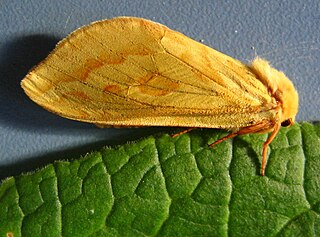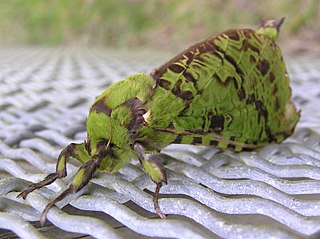
The Hepialidae are a family of insects in the lepidopteran order. Moths of this family are often referred to as swift moths or ghost moths.

The ghost moth or ghost swift is a moth of the family Hepialidae. It is common throughout Europe, except for in the far south-east.

Aenetus is a genus of moths of the family Hepialidae. There are 24 described species found in Indonesia, New Guinea, New Caledonia, Australia and New Zealand. Most species have green or blue forewings and reddish hindwings, but some are predominantly brown or white. The larvae feed in the trunks of living trees, burrowing horizontally into the trunk, then vertically down.

Norman Barnett Tindale AO was an Australian anthropologist, archaeologist, entomologist and ethnologist.

Fraus is a genus of moths of the family Hepialidae. There are 25 described species, all endemic to Australia.

The gold swift is a moth belonging to the family Hepialidae. Until recently it was placed in the genus Hepialus. The species was first described by Carl Linnaeus in his 1758 10th edition of Systema Naturae. It is a widespread species of Europe, its distribution following that of its food plant, bracken.

Abantiades latipennis, known as the Pindi moth, is a species of moth in the family Hepialidae. It may also be referred to as a swift moth or a ghost moth, as this is a common name associated with Hepialidae. Endemic to Australia and identified in 1932, it is most populous in temperate rainforest where eucalypti are prevalent, as the larvae feed primarily on the roots of these trees. Females lay eggs during flight in a scattering fashion. The larvae live for over eighteen months underground, while adult moths survive for approximately one week, as they have no mouthparts with which to feed. The moths are preyed upon by a number of predators, including bats and owls. Brown in colour overall, males are paler and the identifying silver bars of the male's wings are more prominent than those of the female's, with dark margins. Male adults are generally smaller.

Abantiades barcas is a moth of the family Hepialidae. It is endemic to the Australian Capital Territory, New South Wales and Queensland.

Amblyptilia pica, the geranium plume moth, is a moth of the family Pterophoridae. The species was first described by Baron Walsingham in 1880. It is found in western North America from Alaska to California, inland to Alberta and Kansas. It is also found in the north-eastern United States and Ontario.
Aglossa furva is a species of snout moth in the genus Aglossa. It was described by Carl Heinrich in 1931. It is found in North America, including the type location of British Columbia.
Abantiades albofasciatus is a moth of the family Hepialidae. It is endemic to Western Australia.
Bordaia furva is a species of moth of the family Hepialidae. It is endemic to Western Australia.
Bordaia karnka is a species of moth of the family Hepialidae. It is endemic to Western Australia.
Bordaia moesta is a species of moth of the family Hepialidae. It is endemic to Western Australia.
Bordaia paradoxa is a species of moth of the family Hepialidae. It is endemic to Western Australia.
Bordaia pica is a species of moth of the family Hepialidae. It is endemic to South Australia, Victoria and Western Australia.

Sthenopis pretiosus, the gold-spotted ghost moth, is a species of moth of the family Hepialidae. It was first described by Gottlieb August Wilhelm Herrich-Schäffer in 1856. It can be found in found Brazil, Venezuela and in the north-eastern United States and south-eastern Canada.
Eressa furva is a moth of the family Erebidae. It was described by George Hampson in 1898. It is found in Sri Lanka and on Buru.
This page is based on this
Wikipedia article Text is available under the
CC BY-SA 4.0 license; additional terms may apply.
Images, videos and audio are available under their respective licenses.









